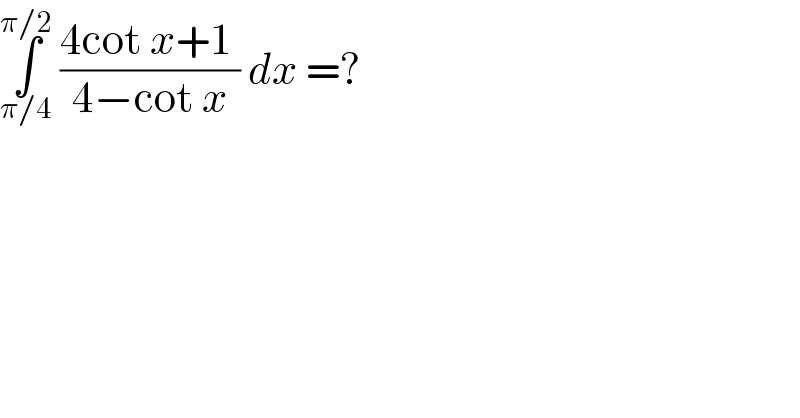Question Number 117176 by bemath last updated on 10/Oct/20

Commented by bemath last updated on 10/Oct/20
![the other way ((4cot x+1)/(4−cot x)) = cot (x−cot^(−1) (4)) ∫_(π/4) ^(π/2) ((4cot x+1)/(4−cot x)) dx = [ ln (sin (x−cot^(−1) (4))]_(π/4) ^(π/2) = ln (sin ((π/2)−cot^(−1) (4))−ln (sin ((π/4)−cot^(−1) (4)) = ln (((cos (cot^(−1) (4)))/(sin ((π/4)−cot^(−1) (4)))) = ln (((4/( (√(17))))/(((√2)/2)((4/( (√(17))))−(1/( (√(17)))))))) = ln (((4(√2))/3))](https://www.tinkutara.com/question/Q117180.png)
Answered by TANMAY PANACEA last updated on 10/Oct/20

Commented by bemath last updated on 10/Oct/20

Answered by AbduraufKodiriy last updated on 10/Oct/20

Commented by bemath last updated on 10/Oct/20

Commented by AbduraufKodiriy last updated on 10/Oct/20

Answered by Dwaipayan Shikari last updated on 10/Oct/20
![∫_(π/4) ^(π/2) ((4cosx+sinx)/(4sinx−cosx))dx =[log(4sinx−cosx)]_(π/4) ^(π/2) =2log(2)−log((3/( (√2)))) =(5/2)log(2)−log(3)](https://www.tinkutara.com/question/Q117190.png)
Answered by mathmax by abdo last updated on 10/Oct/20
![A =∫_(π/4) ^(π/2) ((4cotan(x)+1)/(4−cotanx))dx ⇒ A =∫_(π/4) ^(π/2) (((4/(tanx))+1)/(4−(1/(tanx)))) dx =∫_(π/4) ^(π/2) ((4+tanx)/(4tanx−1))dx =_(tanx =t) ∫_1 ^∞ ((4+t)/(4t−1))(dt/(1+t^2 )) =∫_1 ^∞ ((t+4)/((4t−1)(t^2 +1)))dt let decompose F(t)=((t+4)/((4t−1)(t^2 +1))) F(t) =(a/(4t−1)) +((bt+c)/(t^2 +1)) a =(4t−1)F(t)∣_(t=(1/4)) =(((1/4)+4)/((1/(16))+1)) =((17)/4)×((16)/(17)) =4 lim_(t→+∞) tF(t) =0 =(a/4) +b ⇒b =−1 F(0) =−4 =−a +c ⇒c=a−4 =0 ⇒F(t)=(4/(4t−1))+((−t)/(t^2 +1)) ⇒ ∫_1 ^∞ F(t)dt =∫_1 ^∞ ((1/(t−(1/4)))−(1/2)((2t)/(t^2 +1)))dt =[ln∣((t−(1/4))/( (√(t^2 +1))))∣]_1 ^∞ =−ln∣((3/4)/( (√2)))∣ =−ln∣(3/(4(√2)))∣ =−ln(3)+ln(4(√2)) =2ln(2)+(1/2)ln2−ln(3) =(5/2)ln(2)−ln(3)](https://www.tinkutara.com/question/Q117248.png)
